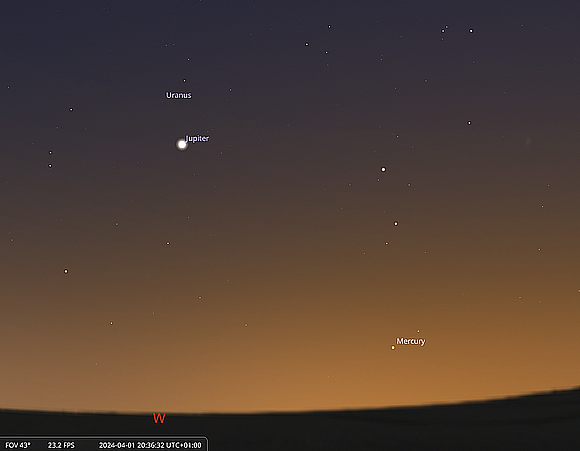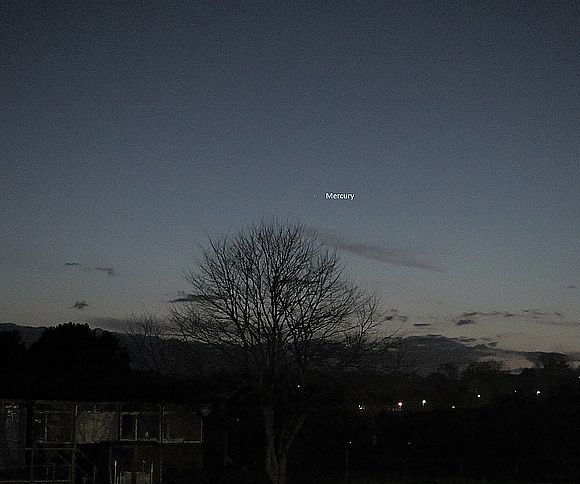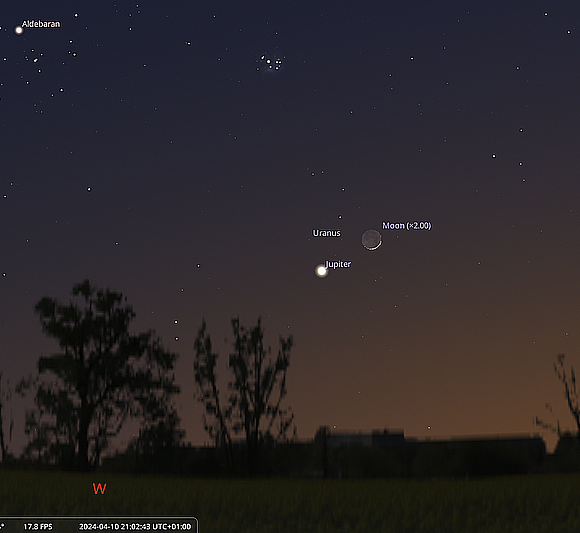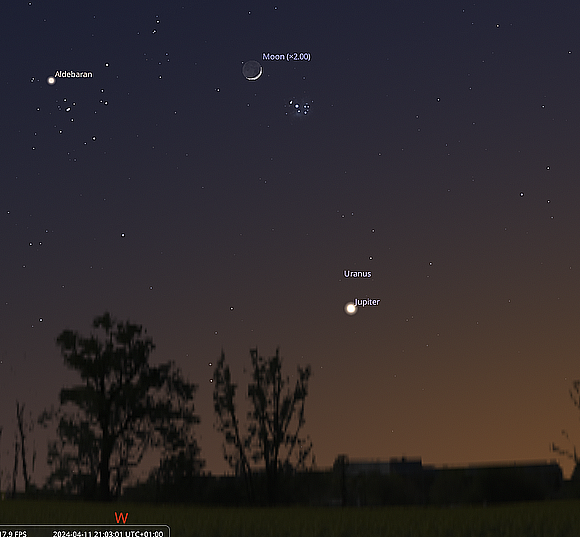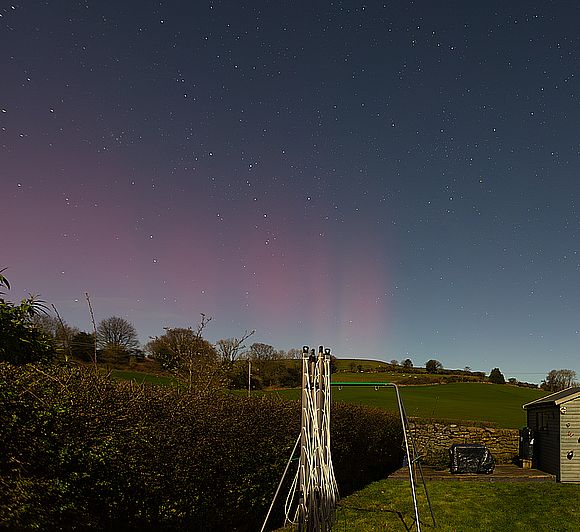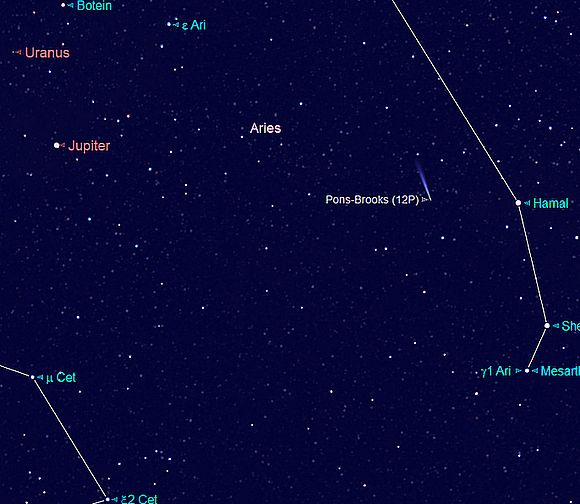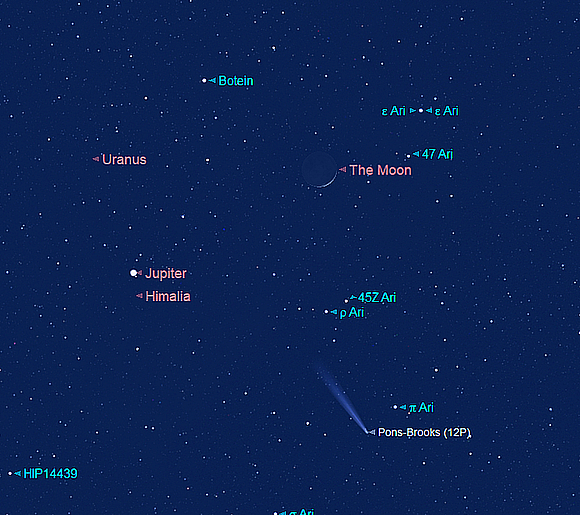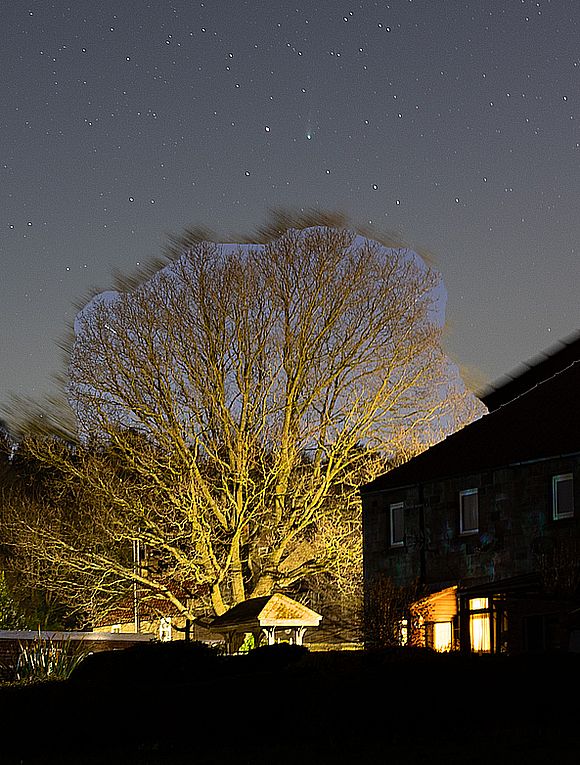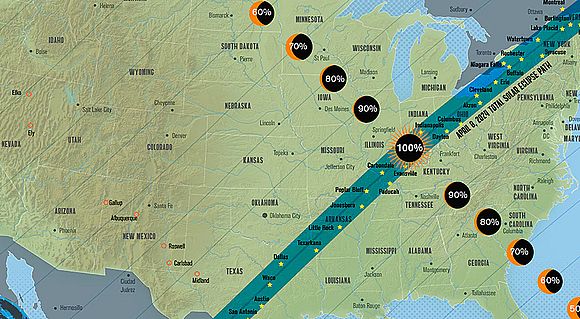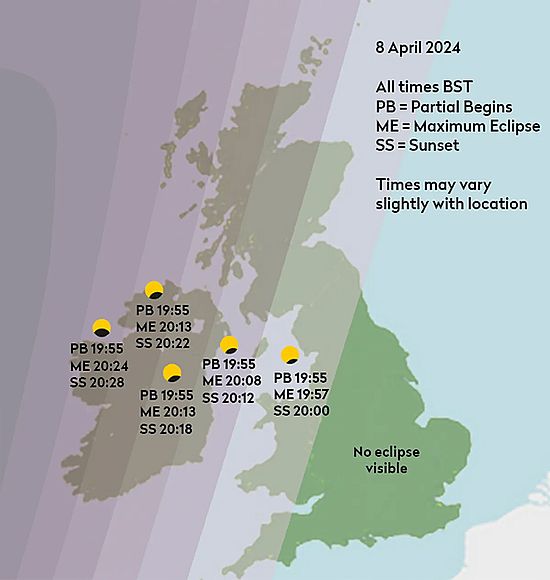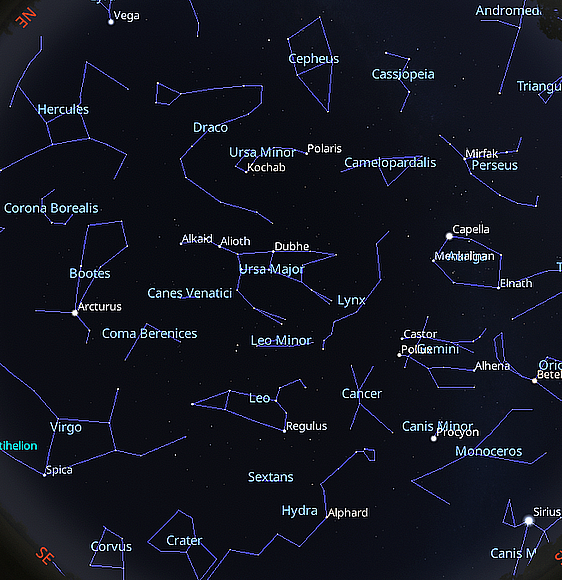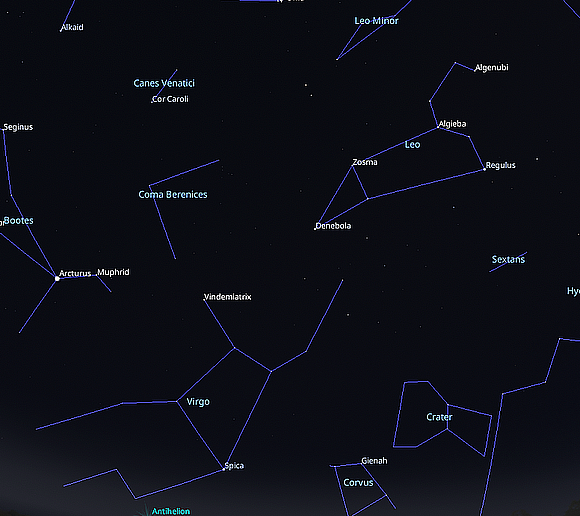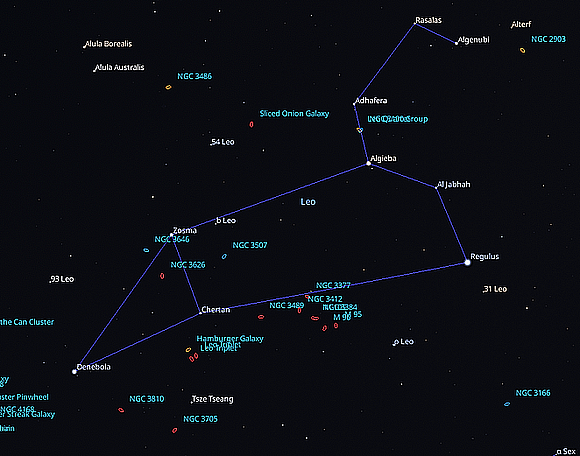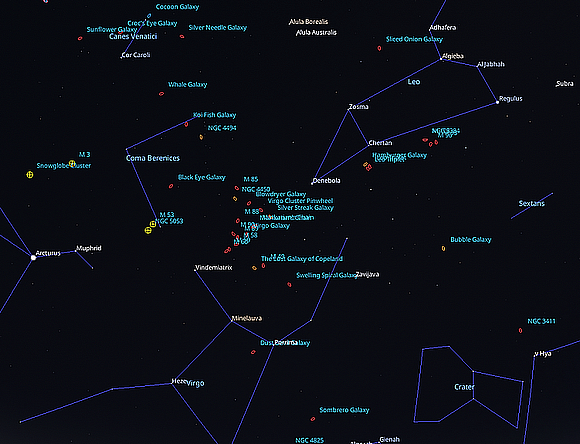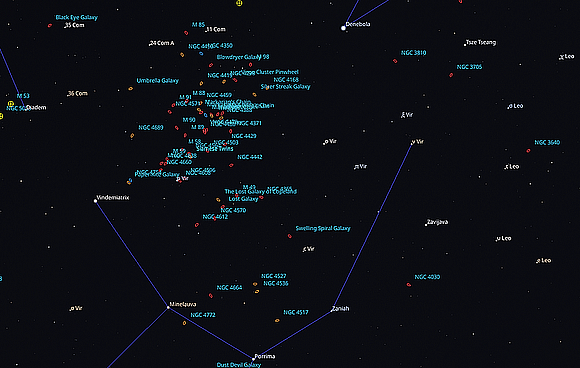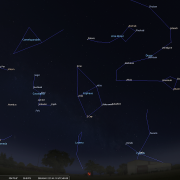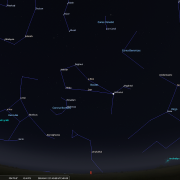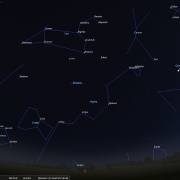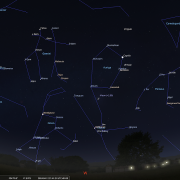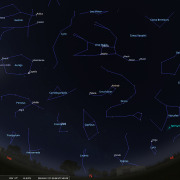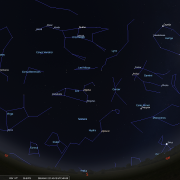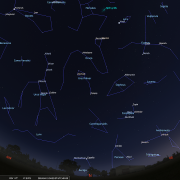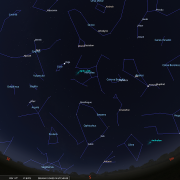In this month's Sky Notes:
- Planetary Skylights.
- April Meteors, Aurora & Comet 12P/Pons-Brooks.
- Solar Eclipse - USA.
- April night Sky.
- April 2024 Sky Charts.
Planetary Skylights: A Brief Guide to April's Night Sky
Jupiter can be followed down to the NW horizon during April before it is lost at the start of May, it is accompanied by Uranus. Mercury concludes its fine evening apparition during the first week in April. Little to talk about in the dawn sky.
 Mercury concludes its spring evening apparition in the first week of April. You may locate it around 35 minutes after sunset (20:25hrs BST) approximately 5 degrees above the WWN horizon. The elusive planet was brightest at the start of the apparition; mid-March, when at magnitude -1.3, but has now faded to +1.45 and will require binoculars to pick it out of the twilight before any attempt to view with just the naked eye.
Mercury concludes its spring evening apparition in the first week of April. You may locate it around 35 minutes after sunset (20:25hrs BST) approximately 5 degrees above the WWN horizon. The elusive planet was brightest at the start of the apparition; mid-March, when at magnitude -1.3, but has now faded to +1.45 and will require binoculars to pick it out of the twilight before any attempt to view with just the naked eye.
April 1st - Mercury just above WWN horizon with Jupiter above - April 1st @ 20:30hrs BST.
(Click for larger image)
 Jupiter's reign as King of the evening planets ends in the final days of the month (technically it is May 2nd before it departs UK skies). Throughout April Jupiter edges ever closer to the NW horizon, its observing window diminishing from barely 3 hours as the month commences, to less than one hour by the end. At magnitude -1.9 Jupiter will remain conspicuous to the naked eye, but as it drops into unstable air closer to the horizon this will diminish somewhat.
Jupiter's reign as King of the evening planets ends in the final days of the month (technically it is May 2nd before it departs UK skies). Throughout April Jupiter edges ever closer to the NW horizon, its observing window diminishing from barely 3 hours as the month commences, to less than one hour by the end. At magnitude -1.9 Jupiter will remain conspicuous to the naked eye, but as it drops into unstable air closer to the horizon this will diminish somewhat.
For UK observers view at the start of the month (around 20:30hrs BST) when Jupiter still lies 20 degrees above the west horizon as dusk falls, not setting until 23:00hrs. This 'viewing window' will gradually erode and by April 30th Jupiter will be just a couple of degrees above the WNW as civil twilight ends. A thin crescent Moon lies right of Jupiter on April 10th with comet Pons-Brooks below in the twilight sky, making for a good potential photographic opportunity.
 Uranus follows Jupiter down to the WNW horizon, the time frame in which to observe it with a telescope not extending much beyond the first week of April for UK observers. Thereafter brightening twilight and very low altitude make it increasingly challenging. At magnitude +5.8 you will require at least a telescope of 75mm or 3" inch at medium magnification to reveal the tiny ghoulish grey/green disk of Uranus. Uranus sits just 3 degrees left of a very slim crescent Moon, and a similar angular separation above Jupiter on April 10th. View around 20:50hrs - 21:20hrs BST. Comet 12P/Pons-Brooks sits 4 degrees below the Moon and may be visible to the naked eye.
Uranus follows Jupiter down to the WNW horizon, the time frame in which to observe it with a telescope not extending much beyond the first week of April for UK observers. Thereafter brightening twilight and very low altitude make it increasingly challenging. At magnitude +5.8 you will require at least a telescope of 75mm or 3" inch at medium magnification to reveal the tiny ghoulish grey/green disk of Uranus. Uranus sits just 3 degrees left of a very slim crescent Moon, and a similar angular separation above Jupiter on April 10th. View around 20:50hrs - 21:20hrs BST. Comet 12P/Pons-Brooks sits 4 degrees below the Moon and may be visible to the naked eye.
April Meteors
April sees a marked increase in meteor activity (albeit from a very low baseline) with several showers active during the month, although normally numbers are still modest. Let's start with what is regarded as the oldest observed meteor shower, the Lyrids (April 16-25th) with recorded sightings by Chinese observers dating back 2,700 years to 687 BC. The Lyrids are a medium strength meteor shower associated with the long periodic comet Thatcher (C/1861 G1), which makes a full orbit of the Sun once every 415 years and was last at perihelion in April 1861. Earth passes through fine debris deposited over time by Comet Thatcher giving rise to the meteors each April.
The shower peaks this year during the early morning hours of April 22nd and under ideal conditions hourly rates exceed 25. Unfortunatetly strong moonlight from a 96% Moon will severly hamper observations this year, rendering the vast majority of Lyrids invisible to the eye. Bright examples may still be spotted as Lyrids can produce bright fireballs. The radiant resides upper right of the bright star Vega in Lyra, visible high to the east during the early morning hours, the optimum time to spot Lyrids.
Early April may yield a few Virginid meteors, however numbers are barely more than sporadic levels; 4 or 5 per hour. Various Virginid radiants exist throughout spring and summer, the one in April reported to lie close to Gamma Virginis. Meteors belonging to this shower are normally slow, of long duration and can produce flared trails. Occasionally this shower produces sporadic outbursts, with several tens per hour. The peak lies around April 12th and won’t be hampered by moonlight this year.
Aurora Sightings
Auroral activity has been quite high of late with some displays being witnessed from our neighbourhood. Predictably most have been obscured by clouds. Richard Randle managed to capture one such display on March 26th, although the intensity was fairly weak and moonlight was present.
Aurora from Richard's back garden - March 26th @ 19:15hrs. Image - Richard Randle. (Click for full image)
Comet 12P/Pons-Brooks
Comet 12P/Pons-Brooks is currently visible in the evening twilight sky and from very dark locations may become a borderline naked eye object. Comet 12P/Pons-Brooks is a 'Halley like' short period comet with an orbital period of 71 years. First discovered by Jean-Louis Pons in 1812, it was then independently rediscovered by William Robert Brooks in 1883 and is the probable parent body causing the κ-Draconids meteor shower. Having undergone several outbursts already, it is certainly worth keeping tabs on as it heads toward perihelion (closest passage to the Sun) on April 21st, coming within 0.78 astronomical units (AU) of it.
The comet will however be best placed for UK observers before then, an easy binocular object visible low in the WNW an hour after sunset. The comet is heading through Aries toward Jupiter but will slip well below it. View as soon as twilight deepens, time and motion are seldom the observer’s friend, and the comet will be slipping down to the horizon all the while.
12P/Pons–Brooks is predicted to be in naked-eye territory in April: mag. 4.8 on 1 April and around 4.1 at the time of perihelion on 21 April, although it is unlikely to be visible from the UK, being right on the horizon. Perhaps try observing up to the 15th, around 21:15hrs BST, the comet will be just 6 degrees or so above the horizon.
It will be interesting to see whether observers in the US and Canada will be able to spot Pons- Brooks during the Total solar eclipse on April 8th. The comet will lie in the same part of the sky as the eclipsed Sun.
Comet 12P above Aisalby treeline. Image not fully edited - Richard Randle - March 30th.
(Click for full image)
Solar Eclipse - USA
There will be a total solar eclipse visible from North America with the eclipse path cutting a swathe across parts of Mexico, the US, and Canada on April 8th. The eclipse will begin over the South Pacific Ocean, with first landfall in continental North America being Mexico’s Pacific coast at around 11:07hrs PDT.
The path of the eclipse will continue through central Mexico, entering the United States where 15 states from Texas to Maine will experience totality, before the path cuts across Southern Ontario in Canada exiting the coast of Newfoundland, at 17:16hrs NDT. Fringes of Western Europe will experience a partial solar eclipse as the Sun is setting, including west and Northwest UK.
Sadly, from the south and east of the UK (including Whitby) nothing will be seen of the eclipse, the Sun having set. To follow events on the day (afternoon from our side of the pond) type 'solar eclipse live' into your search engine, a multitude of sites will be covering it - including NASA live. Should be interesting to see as to whether comet pons/brooks will be visible.
April Night Sky
April is possibly the most difficult month to attribute weather variations to - April showers aside. It is a month that can be dire: I will go as far to say, April can sometimes feel like the worst month of the year, cloudy, dull, wet and cold! On the other hand, if conditions are fine, it can be almost summer like. One thing that doesn't change is the fact that in the northern hemisphere, twilight margins are rapidly growing lighter, and the period of truly dark sky (astronomical twilight) is being eroded, to less than 5 hours by the end of April. If the prospect of burning the observing midnight oil is not a problem, then April is a perfectly fine observers’ month, otherwise, make good use of any opportunities presenting themselves earlier on, when evenings are darker.
In the night sky, seasonal winter constellations are slipping down westwards, allowing an ensemble of spring constellations centre stage. In the west, Taurus heads the winter entourage down to the horizon, the arrow head shaped Hyades star cluster (highlighted by fiery Aldebaran- ‘the eye of the bull’) pointing the way. It is however Orion himself following his march across our skies first to slip below the horizon. Bright Rigel, then the three belt stars, before finally the ‘ruddy’ hue of Betelgeuse disappears.
The brightest star in the entire night sky, Sirius- the ‘dog star’ in Canes Major sparkles just above the SSW horizon, catching the eye, and the unwary, who even mistake it for a UFO (yes, worrying isn’t it). Rest assured its alarming scintillation is purely down to our turbulent atmosphere. Somewhat higher in the SSW, look for solitary Procyon, chief star in the Lesser Dog of Canis Minor. Higher still in the west, the twins of Gemini descend feet first above Taurus, their heads marked by the stars, Castor and Pollux respectively. Of all the bright winter stars visible, only Capella in Auriga the charioteer, found high in the NW will remain, spending the summer months skirting the north horizon. The brightest 'star' in the west is the planet Jupiter set to depart at the end of the month.
By the time astronomical twilight commences, the remainder of the sky to the south and east can at first sight appear somewhat sparse when compared to the majestic winter canopy disappearing into the west afterglow. Like some great musical overture in which quieter interludes are played, the spring sky could be likened to one of these. This is not to say there is nothing of interest to observe, far from it. Instead of star clusters and nebulae the winter sky offers, the spring sky is predominately all about galaxies.
Considered spring’s signature constellation, Leo is one of the most important constellations in the entire sky. During April the lion stands guarding his territory to the south, its head and mane marked by a distinctive stellar asterism known as the ‘sickle’ – the gardening implement, which resembles a backwards question mark. At the base of this arrangement shines Leo’s chief star, Regulus, faintest of the 1st magnitude stars visible in the night sky. Regulus sits almost on the ecliptic and is often involved in conjunctions with the Moon, as well as planetary conjunctions. In antiquity, from 4000 to 2000 BC Regulus was counted as one of the four Royal stars, those bright stars nearest the position of the equinoxes and solstices. During this period Regulus was closest to the summer solstice position, but over the millennia the effects of precession have moved this position away.
The hindquarters of Leo are marked by a triangular arrangement of stars with Denebola marking the rear point. Immediately below this triangle, and to the right, several small galaxy groups may be glimpsed. Behind Leo lie the smattering of stars marking Coma Berenices, a constellation rich in deep sky objects (galaxies mostly) including the Messier objects M53, (a globular cluster) M64, M85, M88, M91, M98, M99 and M100 (all galaxies) as well as the coma galaxy cluster, some 300 million light year distant.
Ahead of Regulus and following the twins of Gemini, the faint stars of Cancer the Crab mark the forward boundary of those constellations associated with the spring section of the zodiac The stars of the Crab may be faint, but the constellation contains the famous open cluster M44 - the Beehive or Preceipe. In antiquity the word 'Nebulous' specifically meant the Preceipe cluster. The cluster is visible to the naked eye as a hazy patch of light on clear, moonless nights and is a fine sight in a small telescope. Cancer also contains the distant open cluster M67 which resides close to the southern border of Cancer, well below the Beehive.
Below the Crab and bright Procyon in Canis Minor, note the knot of fainter stars that mark the head of Hydra - the Water Snake, largest constellation in the heavens. From this distinctive irregular loop, the snakes body slips southeast through its brightest star Alphard - ‘the solitary one’, located to the south, before slithering all the way to ESE horizon. Hydra is such a large constellation, the tail stars are not fully visible above the SE horizon until the midnight hour!
Upon its sinuous coils ride two small, but quite distinct constellations, Crater the Cup and Corvus the Crow. You can locate both above the SSE horizon by 22:00hrs. The faint outline of Crater does indeed resemble a cup or goblet, whilst the outline of Corvus is that of a quadrilateral, sometimes referred to as Spica’s Spanker, a Spanker being a type of sail of similar outline to Corvus.
Spica resides upper left of Corvus and is the chief star in Virgo, visible low in the SE by 22:00hrs. After being absent below the horizon for almost 6 months, Virgo, the Sower of crops, occupies much of the southeast aspect above the horizon, its outline suggestive of a bowl or wide cocktail glass, with a crooked stem (a bit like a distorted ‘Y’ pattern). Invisible to the naked eye, many galaxies belonging to the Virgo cluster 'fizz' just above glass, with others also visible within, many seen in amateur telescopes as fuzzy blobs.
The whole region of sky bounded by the 'bowl', Coma and the hindquarter of Leo is often referred to as the 'realm of the galaxies', being a window onto the wider universe, well away from intervening galactic gas and dust. Messier galaxies alone within the constellation number 11; M49, M58, M59, M60, M61, M84, M86, M87, M89, M90 and M104 - the Sombrero galaxy.
Finally, look to the east to spy the lovely orange hue of Arcturus in the constellation of Boötes, returning to UK skies following its short winter absence. After Sirius, Arcturus is the brightest star visible from the UK, its soft orange lustre in marked contrast to the sparkling diamond of the Dog star. As a challenge within a test (see In Focus - Stellar Bakers Dozen 2023) note how far into April you can spot both Sirius and Arcturus above the horizon at the same time.
Arcturus and Spica may be located by using the pattern of the Plough, found high up in the NE. Simply follow the curve of the handle round and continue this trajectory to Arcturus. From there project a line to the SE, and bingo, you have Spica. So, remember, from the Plough ‘arc to Arcturus, then speed on to Spica’. Plain sailing really!
April Sky Charts
Additional Image Credits:
- Planets and Comets where not otherwise mentioned: NASA
- Sky Charts: Stellarium Software and Starry Night Pro Plus 8
- Log in to post comments

